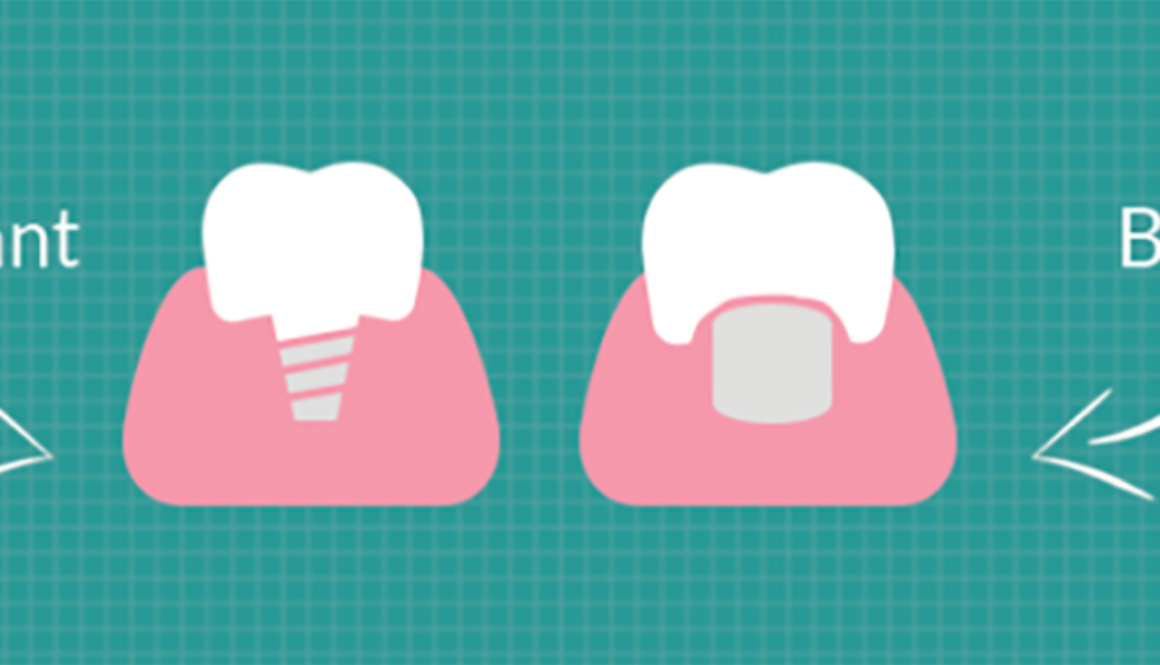Benefits of an Implant versus a Bridge
I frequently talk with patients after they have had a tooth removed about their options to replace the gap. They don’t know whether to pursue an implant or a dental bridge. The most common questions they have are “what is the best option and which is the most expensive?” Since these are so commonly asked I thought it would help to answer these questions as well as the benefits of an implant versus a bridge here.
What exactly are Dental Implants?
Definition: A dental implant is a titanium screw that is placed into the jaw bone and allowed to fuse for several months before a dental prosthesis such as a crown, bridge, or denture prosthesis is later placed . The biggest benefits of an implant is that more tooth structure can be preserved with the usage of implants since the adjacent teeth are not drilled.
| Advantages | Disadvantages |
| Adjacent teeth are not affected | Minor surgery required |
| Does not decay | Minor surgery required |
| Reliable, aesthetic | More expensive |
| Doesn’t develop gum disease | Healing time required before permanent teeth replacement. |
Implants are a good option if you have lost teeth due to an injury or decay. Your dentist will wait a process called as osseo integration, to form an intimate bond between the titanium used and surrounding bone and this is the reason we have to wait. The success rate of dental implants is very high and they are commonly done in many dental and surgical offices.
Now, Dental Bridges-
Definition: These bridges are used to bridge the gap between one or more missing teeth. It gets its support from natural teeth or the implants on either side. It is made of two or more crowns for the teeth on each part of the gap. The anchoring and the false teeth that lie in between are called as abutment teeth and pontics respectively.
| Advantages | Disadvantages |
| Functional, predictable | Requires enamel removal of adjacent teeth |
| Less costly | Adjacent teeth’ crowns must be redone |
| Less time for final results | Root canal required if nerves are affected |
| Potential problem of tooth decay | |
| Gum disease can develop | |
| Lesser longevity than dental implants |
Types of Dental Bridges
Traditional bridges
These are made of either ceramic or porcelain material fused to metal. This bridge is created by a crown for the tooth or by implants on either side of the gap, and the pontic (false teeth) lies in between.
Maryland bonded bridges
The false tooth is fused to the metal bands that are bonded to the abutment teeth with a resin which is hidden from view. This resin bonded bridge is made of porcelain fused to metal or plastic teeth supported by a metal framework. The pre-existing teeth on both the sides of the gap are bonded to the metal or porcelain made wings on the bridge. These bridges are often used in the areas of your mouth that are under less stress such as your front teeth.
Cantilever bridges
These are an excellent solution when traditional bridges can’t be used. These bridges are most often used when abutment teeth are located on only one side of the missing tooth or in areas of the mouth that are under a lot of stress. The layout is different even though this bridge uses the same number of dental crowns.
Implant vs Bridge
| Key Aspects | Implant | Bridge |
| How long does it last? | 15+ years | 5-7 years |
| Long-term dental health | Little to no bone/gum loss | Some bone/gum loss |
| Oral Hygiene maintenance | Brush & Floss normally | Needs special floss & brush |
| Appearance matters | Best Possible Aesthetics | Very Natural in appearance |
The final verdict is implants have a very high long-term success rate. But unique situations call for a choice between the two (and every patient is unique), for which you would need to consult your dentist. I hope this review has been helpful.
For more details on the benefits of implants versus dental bridges, feel free to contact me Dr. Libby Finnessy of Bellevue Dental Health at 425-641-3311 or at info@bellevuedentalhealth.com.



